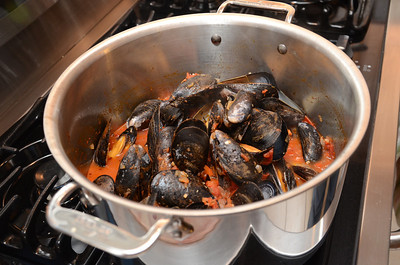Whenever I see mussels, I think of Belgium, specifically its capital, Brussels. No matter where you go in this medieval city, you invariably come across someone selling these succulent bivalves. Whether served with fries, as in moules frites, or in an herb-white wine broth, as in moules marinière, mussels are a common treat in this land.
Belgians aren’t alone in their love of mussels. Archeological evidence indicates that Europe has been consuming these dark blue- to black-shelled mollusks for over 20,000 years.

Unlike Europeans, I was a bit of a late comer to this shellfish. Now, though, I’m hooked on its creamy texture and mildly sweet flavor that’s slightly reminiscent of lobster. I also love its eco-friendliness. Take, for instance, the North American blue mussel. It grows in abundance, is low in contaminants and doesn’t adversely affect the environment. Plus, it’s both inexpensive and delicious. Can’t ask for more than that!
Although dozens of species exist, I most often see the aforementioned blue mussels. Found on the Mediterranean, Atlantic and Pacific coasts, blue mussels range from two to three inches in length and have a dark blue shell. Unless otherwise indicated, recipes will normally call for this species of mussel.
In terms of quality, the tinier the mussel is, the better the dining experience will be. As always, avoid those with broken or damaged shells. Steer clear of overly heavy or lightweight and rattling ones. The former may be weighed down with sand. The latter may contain a dead mussel.
Before cooking mussels, I consider what foods go well with them. Their juicy meat marries nicely with celery, clams, garlic, lemon, onions, pasta, potatoes, shallots, spinach and tomatoes. They are complimented by such herbs and spices as chives, curry powder, mustard and tarragon. In terms of cooking liquids they respond beautifully to Belgian or Belgian-style beer, cream, olive oil, Pernod, red wine vinegar, vermouth and dry white wine.
MUSSELS PROVENCAL
Serves 4 as an entrée; 6 as an appetizer
When cleaning mussels, discard those with broken shells or that don’t close up when tapped on the shell. These are already dead and should not be cooked with the live mussels.
3 tablespoons olive oil
1 medium yellow onion, diced
1/4 teaspoon salt
4 cloves garlic, minced
1 red bell pepper, washed and diced
11/2 teaspoons dried thyme
1 teaspoon dried basil
1 teaspoon capers, rinsed
1 (28-ounce) can diced tomatoes and its juices
1 cup white wine
juice of 1 lemon
1/2 teaspoon ground black pepper
4 pounds mussels, scrubbed and beards removed
1/2 cup flat leaf parsley, washed and chopped
toasted baguette or batard, for serving
In a medium stockpot heat the olive oil. Add the onion and salt and sauté until softened, 5 to 7 minutes. Add the garlic, bell pepper, thyme and basil and sauté for another 5 minutes. Tumble in the tomatoes, white wine, and black pepper, bring to a boil and simmer for 5 minutes. Taste and adjust for seasonings before adding the mussels. Cover the pot and allow the mussels to cook until opened, about 5 to 10 minutes. Don’t overcook the mussels as this will make them tough. Add the parsley and toss to combine. Spoon the mussels into a large bowl and pour the sauce over top. Serve alongside toasted baguette or batard.